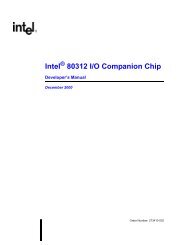Wireless Intel SpeedStep Power Manager
Wireless Intel SpeedStep Power Manager
Wireless Intel SpeedStep Power Manager
Create successful ePaper yourself
Turn your PDF publications into a flip-book with our unique Google optimized e-Paper software.
White Paper<strong>Wireless</strong> <strong>Intel</strong> <strong>SpeedStep</strong> ® <strong>Power</strong> <strong>Manager</strong>Read PMUEventsCalculatethe StatisticDeterminethe StateInterfacewith PM<strong>Power</strong> <strong>Manager</strong> Idle ProfilerFigure 9. Performance ProfilerThe PMU tracks processor events as described in Table 2. ThePerformance Profiler also monitors the status registers ofperipheral devices such as the <strong>Intel</strong> PXA27x processor’s LCDController. This monitoring allows the Performance Profiler todynamically characterize the system state.8.0 Policy <strong>Manager</strong>The Policy <strong>Manager</strong> defines power states and maps them topower modes of the <strong>Intel</strong> PXA27x processor and/or <strong>Wireless</strong><strong>Intel</strong> Communications Processor. If a power state is native tothe operating system, the Policy <strong>Manager</strong> uses the nativepower state and the operating system’s interface to the DPIsto transition the system into the specified power state. If thepower state is not native to the operating system, the Policy<strong>Manager</strong> creates the power state and uses the DPIs totransition the system into the specified power state.The Policy <strong>Manager</strong> uses device driver inputs, applicationworkload inputs (optional), Idle Profiler inputs, and PerformanceProfiler (system workload) inputs to define the system’s powerpolicy. Alternatively, an OEM can use these inputs to define itsown power policy.The <strong>Power</strong> <strong>Manager</strong> software provides an infrastructure to thedevice drivers for state changes, frequency changes, and voltagechanges. Using this infrastructure, the <strong>Power</strong> <strong>Manager</strong> softwarenotifies the client drivers of these changes either directly orthrough the operating system’s power management services.A system that is enabled by the <strong>Power</strong> <strong>Manager</strong> software willalways maintain a predefined operating point as part of a globalvariable, namely IPMOperatingPoint = [State, Voltage, Frequency,Frequency2, Frequency3]Information SourcePMU RegistersDescription of EventInstruction cache-missInstruction cache cannot deliverinstructionData dependency stallInstruction TLB missData TLB missInstruction executedNumber of Stalls an number of times thestall occurs due to D-Cache buffer full(every cycle condition is present)Data cache accessData cache-missData cache write-backSoftware changed the PCUsage for CharacterizationInstruction traffic and CPI estimation andcache locality%Memory usePage locality%CPU UsedData traffic / Data access congestion /Congestion rate and congestion lengthsData access rate, memory bound,%Memory useData traffic and %Memory useData trafficNumber of function callsTable 2. <strong>Intel</strong> ® PXA27x Processor’s Performance Monitoring Unit (PMU)12
















